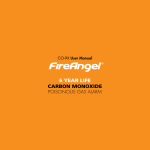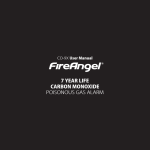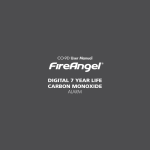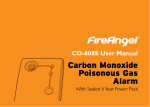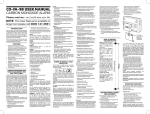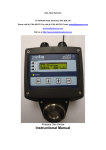Download Zeta Alarm Systems ZD-CO-9X User manual
Transcript
ZD-CO-9X User Manual 7 YEAR LIFE CARBON MONOXIDE POISONOUS GAS ALARM CONTENTS INTRODUCTION FEATURES 2 2 CARBON MONOXIDE AND HOW IT CAN AFFECT YOU AND YOUR FAMILY 3 WHERE TO INSTALL YOUR DETECTOR 5 HOW TO INSTALL YOUR DETECTOR 7 POWER PACK ACTIVATION 8 POWER PACK DEACTIVATION 9 OPERATING FEATURES 9 UNDERSTANDING THE PRODUCT’S INDICATORS 12 MAINTAINING / TESTING YOUR DETECTOR 13 WHAT TO DO IN THE EVENT OF AN ALARM 14 USEFUL NUMBERS 15 TECHNICAL INFORMATION 16 DISPOSAL 17 7 YEAR WARRANTY 18 RETURNS 19 PRODUCT RANGE 19 NOTES / DISABLING TAB STORAGE PAGE 20 Note: This User Manual is also available in large text and other formats. Please call +44 (0) 1792 455 175 for further information INTRODUCTION FEATURES Congratulations! You’ve made a wise investment in an innovative product and your personal safety. The ZD-CO-9X 7 Year Life Carbon Monoxide Poisonous Gas Alarm is one of a new generation of domestic life safety products from Zeta Alarm Systems, which combines the latest technology and innovative design to provide an aesthetically pleasing and effective contribution to your home safety. • An advanced electrochemical sensor designed to accurately measure low levels of carbon monoxide (CO) providing an early warning of toxic CO levels in your home • Detects carbon monoxide continuously • Resistant to false alarms caused by normal household contaminants • Sounds a loud 85dB alarm (at 1metre (3 feet)) to alert you in case of an emergency • Test/reset button • Regular self-check to ensure detector is operating correctly • Simple to mount, portable, ideal for travelling • Certified to the European Carbon Monoxide alarm Standard BS EN 50291 : 2001 • 7 year warranty The Zeta range of products is constantly being improved and expanded. Please visit www. zetaalarmsystems.com to find out about the latest additions to our product range. Zeta Alarms Systems provide some of the most technologically advanced carbon monoxide detectors in the world. 2 CARBON MONOXIDE AND HOW IT CAN AFFECT YOU AND YOUR FAMILY Carbon monoxide is a dangerous, poisonous gas that kills hundreds of people each year and injures many more. It is often referred to as the silent killer because it has no odour or taste and cannot be seen. Like oxygen, CO enters the body through the lungs during the normal breathing process. It competes with oxygen by replacing it in the red blood cells, thereby reducing the flow of oxygen to the heart, brain and other vital organs. In high concentrations, CO can kill in minutes. Many cases of reported carbon monoxide poisoning indicate that while victims are aware they are not feeling well, they become disorientated and unable to save themselves by either exiting the building or calling for assistance. Exposure during sleep is particularly dangerous because the victim usually does not wake up. Symptoms of CO poisoning The following symptoms may be related to CO poisoning which all household members should be made aware of: • Mild Exposure: Slight headache, nausea, vomiting, fatigue (often described as ‘flulike’ symptoms). • Medium Exposure: Severe throbbing headache, drowsiness, confusion, fast heart rate. • Extreme Exposure: Unconsciousness, convulsions, cardiorespiratory failure, death. Your Zeta CO detector monitors the level of CO as parts per million (ppm) in the atmosphere surrounding the detector. 35ppm The maximum allowable concentration for continuous exposure for healthy adults in any 8 hour period, as recommended by the Occupational Safety and Health Administration (OSHA). 200ppm Slight headache, fatigue, dizziness, nausea after 2 - 3 hours. 400ppm Frontal headaches within 1 - 2 hours, life threatening after 3 hours. 800ppm Dizziness, nausea and convulsions within 45 minutes. Unconsciousness within 2 hours. Death within 2 - 3 hours. Should you suspect CO may be affecting you or your family, open the doors and windows of your property to ventilate, turn off your appliances and evacuate the premises. At this time the authorities should be contacted 3 to locate the source of the carbon monoxide before re-entering the building. Medical attention should be sought for anyone suffering the effects of CO poisoning (headache, nausea, see page 3). Common sources of CO • Oil and gas boilers • Portable generators • Oil or solid fuel cookers • Gas or paraffin heaters • Barbecues • Clogged chimneys • Wood or gas fireplaces • Cigarette smoke • Gas appliances • Any fossil fuel burning appliance WARNING: This Zeta carbon monoxide detector is not a combustible gas detector, nor a smoke detector. Please install the proper detectors to detect combustible gases, or smoke. This CO detector should not be seen as a substitute for the proper installation, use, and maintenance of fuel-burning appliances (including appropriate ventilation and exhaust systems), nor the sweeping of chimneys. WARNING: Do not use this carbon monoxide detector on an intermittent basis, or as a portable detector for trying to 4 trace one source of the spillage of combustion products from fuel-burning appliances or from chimneys. Do not: •IGNORE ANY WARNING FROM YOUR CO DETECTOR! •Burn charcoal inside your home, caravan, tent or cabin •Install, convert or service fuel-burning appliances without proper knowledge, skill and expertise •Use a gas cooker for heating a room •Operate unvented gas burning appliances using paraffin or natural gas in closed rooms •Operate petrol-powered engines indoors or in confined areas •Ignore a safety device when it shuts an appliance off Always: •Buy appliances accepted by a recognised testing laboratory •Install appliances according to the manufacturer’s instructions •Have appliance installations carried out by professionals (for gas appliances engineers should be registered) •Have your appliances checked regularly by a qualified service engineer •Have your chimneys and flues cleaned professionally every year •Make regular visual inspections of all fuelburning appliances •Do not barbecue indoors, or in an attached garage •Open windows when a fireplace or oil/ solid fuel cooker is in use •Only install CO detectors that meet the requirements of BS EN 50291:2001 in your home •Be aware of CO poisoning symptoms (see page 3) EDUCATE YOURSELF AND YOUR FAMILY ON THE SOURCES AND SYMPTOMS OF CO POISONING AND HOW TO USE YOUR CARBON MONOXIDE DETECTOR WHERE TO INSTALL YOUR DETECTOR WARNING: This detector will only indicate the presence of carbon monoxide gas at the sensor. Carbon monoxide gas may be present in other areas. In which room should the detector be installed? Ideally, an apparatus should be installed in every room containing a fuel burning appliance. Additional apparatus may be installed to ensure that adequate warning is given for occupants in other rooms, by locating apparatus in: •Remote rooms in which the occupant(s) spend considerable time whilst awake and from which they may not be able hear an alarm from apparatus in another part of the premises, and •Every sleeping room. However, if there is a fuel burning appliance in more than one room and the number of apparatus is limited, the following points should be considered when deciding where best to put the apparatus: •Locate the apparatus in a room containing a flueless or open-flued appliance, and •Locate apparatus in a room where the occupant(s) spend most time. •If the domestic premises is a bedsit (a 5 single room serving as both sitting and bedroom) then the apparatus should be put as far from the cooking appliances as possible but near to where the person sleeps. •If the appliance is in a room not normally used (for example a boiler room), the apparatus should be put just outside the room so that the alarm may be heard more easily. Alternatively, a remote alarm siren may be connected to a type A apparatus located in a room(s) containing a fuelburning appliance. Where in the room should I place the detector? Apparatus located in the same room as a fuel-burning appliance: For both wall and ceiling mounted apparatus the following applies: a The apparatus should be at a horizontal distance of between 1m and 3m from the potential source. b If there is a partition in a room, the apparatus should be located on the same side of the partition as the potential source. c Carbon Monoxide detectors in rooms with sloped ceilings should be located at the high side of the room. In addition to the above the following must be observed: If the apparatus is located on a wall: 6 a it should be located close to the ceiling; bit should be located at a height greater than the height of any door or window; c it should be at least 150mm from the ceiling. If the apparatus is located on the ceiling: a it should be at least 300mm from any wall and any ceiling obstruction e.g. light fittings. Apparatus located in sleeping rooms and in rooms remote from a fuel burning appliance: Apparatus located in sleeping rooms or located in rooms remote from the fuel-burning appliance should be located relatively close to the breathing zone of the occupants Where not to put the detector The apparatus should not be installed: •In an enclosed space (for example in a cupboard or behind a curtain). •Where it can be obstructed (for example by furniture). •Directly above a sink •Next to a door or window •Next to an extractor fan •Next to an air vent or other similar ventilation openings •In an area where the temperature may drop below -10°C or exceed 40°C •Where dirt and dust may block the sensor •In a damp or humid location (for example in a bathroom) •In the immediate vicinity of the cooking appliance WARNING: Prolonged exposure to temperatures outside those stated above will reduce the power pack and sensor life. HOW TO INSTALL YOUR DETECTOR NOTE: This apparatus should be installed by a competent person who feels able to install it according to the instructions. Firstly write the installation date on your detector in the area provided. We recommend that your detector is installed on the wall. To mount on a wall or ceiling: Please ensure that you use the screws provided, as they were chosen specifically for use with this product. Use template below for guidance on marking hole positions. Drill holes into the wall. Insert the plastic wall plugs. Screw in the screws. Ensure screws are protruding from the wall by 3mm to allow detector to slot onto screws. To place on a shelf: The base of the detector has been designed to allow it to stand freely on a shelf. WARNING: When placing on a shelf, please adhere to the same positional recommendations as described on page 5 and 6. Drill hole spacing 66mm 7 POWER PACK ACTIVATION See diagram opposite aYour detector comes complete with an integrated power pack that will provide power for its entire operational life. To activate the power pack you need to pull the disabling tab (see image). This will in turn pull out the metal disabling clip, which is attached to the end of the tab, from the disabling socket which is situated on the underside of the detector. Retain the disabling tab for future use by taping it to page 20 of this manual. bWhen the detector is activated the Power LED will begin to flash green once every minute to indicate that the detector is receiving power from the power pack and is fully operational. c Test the sounder, power pack and circuitry by pressing and holding the centre of the Test/Reset button briefly to confirm that the detector is operating properly. The sounder will sound as soon as the button is pressed, and the Alarm LED will illuminate red indicating that the sounder is working and the power pack is providing power to the unit. This test for the sounder, power pack and circuitry should be performed on a weekly basis. This should be continued for the lifetime of the product. 8 WARNING: Prolonged exposure to the sounder in close proximity to your ears may damage your hearing. Under normal operating conditions, the power pack will last for the lifetime of the product ie. 7 years. WARNING: Prolonged exposure to temperatures outside those stated above will reduce the power pack and sensor life. The detector will not protect against the risk of carbon monoxide poisoning when the power pack has drained. POWER PACK DEACTIVATION Your ZD-CO-9X is portable, making it ideal for taking with you on holiday. You will need to deactivate your detector when travelling or even when storing e.g. when decorating. Fitting is the reverse of removal. To deactivate the detector the two ends of the metal clip must be inserted into the corresponding holes in the disabling socket located on the underside of the detector (see image). You can ensure that the product is disabled by pressing the test button - if there is no sound from the sounder then the clip has been fitted correctly. OPERATING FEATURES Your Zeta detector offers many features which set it apart from other CO detectors on the market today. Test/Reset button feature This button will: •Test the sounder, power pack and circuitry •Allows you to test the sensor by introducing a source of CO into the detector (see ‘Testing The Sensor’ below). •Silence the loud 85dB (at 1 metre (3 feet)) sounder during an alarm (only for alarms due to levels of CO of less than 50ppm) Testing the sounder, power pack and circuitry The clip must remain in the disabling socket to keep the power pack deactivated. NOTE: If the disabling tab is no longer available then the clip can be replicated by opening out a thin metal paper clip into a U-shape. Test the sounder, power pack and circuitry by pressing and releasing the Test/Reset button to confirm that the detector is operating properly. The sounder should sound as soon as the button is pressed, and the Alarm LED will illuminate red indicating that the sounder is working and the power pack is providing power to the unit. This test for the sounder, power pack and circuitry should be performed on a weekly basis. Testing the sensor NOTE: We suggest the use of an incense stick or cigarette as the inefficient 9 way in which these products burn means the smoke given off contains a detectable localised amount of carbon monoxide. Alternative sources of smoke, for example an extinguished candle or match, will not contain sufficient levels of carbon monoxide to obtain a response from the detector during this test. Please note your CO detector will not detect smoke. CAUTION: Sensor testing should only be performed by a responsible adult. This test should only be performed once a month. Excessive testing will cause the life of the power pack to be shortened. NOTE: CO test kits may be used in order to avoid having to burn cigarettes, incense sticks etc. However we recommend that incense sticks are used as they are cheap and readily available. sounder sounds for a second time (this should happen after around 5 seconds). Release the Test/ Reset button. Upon releasing the Test/Reset button the Fault LED will flash yellow once every second. This indicates that the sampling rate of the detector has increased and can be tested using a known source of CO. Test/Reset Button Step 3 • Read all steps thoroughly before attempting to test your the sensor Step 1 Step 2 10 If the detector is wall or ceiling mounted unhook the detector from the screws. Cover the sounder vents with one hand. Press and hold the Test/Reset button down with your thumb/finger until the Fault LED illuminates yellow and the Step 4 Light a cigarette or an incense stick using a match or lighter. If using an incense stick be sure to blow out the flame so that the incense stick is smouldering. Extinguish the lighter, or put out the match and place it into a dish of water. Turn the detector on its side so that the vents on the right hand side of the detector are pointing downwards (see diagram opposite). Hold the burning Step 5 cigarette or incense stick 15 cm (6 inches) below the detector, so that the smoke enters the vents on the side of the detector. An increase in the localised carbon monoxide level within the sensor to more than 50ppm will cause the sounder to sound for one cycle of four loud beeps and the Fault LED to illuminate yellow for a short time. This is the end of the test. The Fault LED will no longer flash yellow and the detector will go back to normal operating mode ie. the Power LED will flash green once every minute (It may take up to two minutes of exposure to the smoke for the localised level of carbon monoxide within the sensor to reach over 50ppm). Now move the source of CO away from the detector as the test is finished. After step 4, put out the incense stick or cigarette by placing it into a dish of water. Ensure that all flames have been extinguished. 15cm (6”) NOTE: If the localised carbon monoxide level within the sensor does not reach 50ppm during the test, the sensor test will stop automatically after 3 minutes. 11 UNDERSTANDING THE PRODUCT’S INDICATORS If the product is still within warranty then contact technical support. If the product is no longer in warranty replace immediately! The higher the concentration of carbon monoxide detected by the detector, the quicker it will respond. When sufficient carbon monoxide is detected a loud audible signal (85 dB at 1m (3 feet)) will be emitted and the Alarm LED will flash red once every second. IMPORTANT: The selected power pack was chosen to provide power beyond the lifetime of the product, in particular the sensor (under normal operating conditions). The sensor life is seven years, for this reason, the detector should be replaced after seven years from the date of installation. The Alarm will sound: •Between 60 and 90 minutes when exposed to a minimum of 50ppm of CO. •Between 10 and 40 minutes when exposed to a minimum of 100ppm of CO. •Within 3 minutes when exposed to a minimum of 300ppm of CO. WARNING: Prolonged exposure to temperatures outside those stated above will reduce the power pack and sensor life. Fault / low power pack signal: The unit continuously checks the settings of its sensor and circuitry. If any of these settings are found to be incorrect or if the power pack becomes low then the detector will emit a single chirp once per minute and the Fault LED will flash yellow once per minute for up to 30 days. IMPORTANT: This does NOT mean that the detector has detected carbon monoxide. 12 Zeta Technical Support Line 9.00am – 5.00pm, Monday – Friday. Telephone: +44 (0) 1792 445 175 e-mail: [email protected] MAINTAINING / TESTING YOUR DETECTOR Maintenance Your detector will alert you to potentially hazardous CO concentrations in your home when maintained properly. To maintain your Zeta detector in proper working order, and to ensure that the sensor will last for the lifetime of the product, it is recommended that you: •Test the sounder, power pack and circuitry of your detector at least once per week by pressing the Test/Reset button briefly (see page 9). • Perform the Sensor Test once every month (see page 9). • Keep the detector free of dust by gently vacuuming the case with a soft brush attachment once per month. store in a plastic bag before painting, wall papering, or performing any other activities using substances that emit strong fumes. Remember to remove it from the bag and replace the detector when these activities are finished. Failure of any test should be reported to the technical support line (see page 19 for contact details). Do not attempt to repair your CO detector. Do not remove any screws or open the main casing of your detector. Any attempt to do so may cause malfunction and will invalidate the warranty. To prevent the possibility of contaminating the sensor in your detector and thus affecting its reliability: • Never use cleaning solutions on your detector. Simply wipe with a slightly damp cloth. • Do not paint the detector. • Do not spray aerosols on or near the detector. • Do not use any solvent based products near the detector. • Move the detector to a safe location and 13 WHAT TO DO IN THE EVENT OF AN ALARM WARNING: A loud alarm is a warning that unusually high and potentially lethal levels of carbon monoxide are present. Never ignore this alarm, further exposure can be fatal. Immediately check residents for symptoms of carbon monoxide poisoning, and contact the proper authorities to resolve all CO problems. NEVER IGNORE ANY ALARM. Please carefully review this owner’s manual to ensure that you know what actions to take in the event of an alarm. What to do during an alarm •Keep calm and open the doors and windows to ventilate the property. •Stop using all fuel burning appliances and ensure, if possible, that they are turned off. •Evacuate the property leaving the doors and windows open. •Ring your gas or other fuel supplier on their emergency number; keep the number in a prominent place. Write your fuel supplier’s emergency number here (see opposite for more useful numbers): ____________________________________ 14 •Do not re-enter the property until the alarm has stopped. When exposed to fresh air it can take up to 10 minutes for the sensor to clear and the alarm to stop depending on the level of carbon monoxide detected. •Get medical help immediately for anyone suffering the effects of carbon monoxide poisoning (headache, nausea), and advise that carbon monoxide poisoning is suspected. •Do not use the appliance again until it has been checked by an expert. In the case of gas appliances the engineer must be registered. UK USEFUL NUMBERS National Gas Emergency Service Gas Safe register 0800 111 999 (24 Hours) 0800 408 5500 Solid Fuel Association Advisory service for domestic and solid fuel appliances 0845 601 4406 HETAS Trade association for solid fuel engineers 0845 223 3033 OFTEC Trade association for Oil Fired Appliance engineer 0845 658 5080 NACS National Association of Chimney Sweeps 0800 833 464 IPHE Institute of Plumbing and Heating Engineers 0870 414 5533 15 TECHNICAL INFORMATION Detector Specifications: Sensor Type: Sensor Life: Alarm Sound Level: Power Pack Life: Temperature Range: Operating Humidity Range: Weight: Certified to: Model ZD-CO-9X Electrochemical 7 Years 85dB at 1 metre (3 feet) 7 years (Life of product) -10ºC (14ºF) to 40ºC (104ºF) 30 - 90% RH 90 grams (3.2oz) BS EN 50291 : 2001 WARNING: Prolonged exposure to temperatures and humidity outside those stated above will reduce the power pack and sensor life. This Zeta carbon monoxide detector is designed to continuously monitor for CO. Its response times meet the requirements of BSI standard BS EN 50291 : 2001. The alarm will sound: •Between 60 and 90 minutes when exposed to 50ppm of CO. •Between 10 and 40 minutes when exposed to 100ppm of CO. •Within 3 minutes when exposed to CO levels of 300ppm or more. 16 WARNING: APPARATUS CONFORMING TO THIS STANDARD MAY NOT PROTECT PEOPLE WHO ARE AT SPECIAL RISK FROM CARBON MONOXIDE EXPOSURE BY REASON OF AGE, PREGNANCY OR MEDICAL CONDITION. IF IN DOUBT, CONSULT YOUR DOCTOR. A CARBON MONOXIDE DETECTOR IS NOT A SUBSTITUTE FOR A SMOKE ALARM OR A COMBUSTIBLE GAS DETECTOR. THE ZD-CO-9X HAS AN OPERATIONAL LIFETIME OF 7 YEARS FROM THE DATE IT IS INSTALLED AND ACTIVATED. RECORD THE DATE OF INSTALLATION ON THE STICKER PROVIDED AND REPLACE UNIT AFTER 7 YEARS OF OPERATION. DISPOSAL Waste electrical products should not be disposed of with regular household waste. Please recycle where facilities exist. Check with your local authority, retailer or manufacturer for recycling/disposal advice as regional variations apply. The power pack should be deactivated before disposal. To do this, insert the pins on the end of the disabling tab back in to the socket on the underside of the detector (See page 9). If the disabling tab is no longer available then the clip can be replicated by opening out a thin metal paper clip into a U-shape. You can also return your carbon monoxide detector to us for disposal. For return address see the section on Returns. Please include a note confirming the product is being returned for disposal. WARNING: DO NOT ATTEMPT TO OPEN - DO NOT BURN 17 7 YEAR WARRANTY Warranty coverage Zeta Alarm Systems warrants to the original purchaser that its enclosed sealed carbon monoxide detector be free from defects in materials and workmanship under normal residential use and service for a period of 7 (seven) years from the date of purchase. Provided it is returned with postage prepaid and proof of purchase, Zeta Alarm Systems hereby warrants that during the 7 (seven) year period commencing from the date of purchase Zeta Alarm Systems, at its discretion, agrees to replace the unit free of charge. The warranty on any replacement Zeta ZD-CO9X 7 Year Life Carbon Monoxide Poisonous Gas Alarm will last for the remainder of the period of the original warranty in respect of the detector originally purchased – that is from the date of original purchase and not from the date of receipt of the replacement product. Zeta Alarm Systems reserves the right to offer an alternative product similar to that being replaced if the original model is no longer available or in stock. This warranty applies to the original retail purchaser from the date of original retail purchase and is not transferable. Proof of purchase is required. Warranty disclaimers This warranty does not cover damage resulting from accident, misuse, disassembly, abuse or 18 lack of reasonable care of the product, or applications not in accordance with the user manual. It does not cover events and conditions outside of Zeta Alarm Systems’ control, such as Acts of God (fire, severe weather etc). It does not apply to retail stores, service centres or any distributors or agents. Zeta Alarm Systems will not recognise any changes to this warranty by third parties. Zeta Alarm Systems shall not be liable for any incidental or consequential damages caused by the breach of any expressed or implied warranty. Except to the extent prohibited by applicable law, any implied warranty of merchantability or fitness for a particular purpose is limited in duration to 7 years. This warranty does not affect your statutory rights. Except for death or personal injury, Zeta Alarm Systems shall not be liable for any loss of use, damage, cost or expense relating to this product or for any indirect, or consequential loss, damages or costs incurred by you or any other user of this product. RETURNS PRODUCT RANGE We recommend that you contact the Zeta Technical Support Line in the first instance on +44 (0) 1792 455 175, as we may be able to remedy the problem quickly over the phone (this is to prevent unnecessary returns that take a longer time to process). Alternatively e-mail: [email protected]. Zeta Alarm Systems provide an extensive range of Fire Alarm Systems, Gas Detection & Emergency Systems. For more details visit www.zetaalarmsystems.com. If there is a fault that we are unable to resolve then our technical support team member will issue you with a returns authority number so that your product can be returned for testing. To return your Zeta CO-9X under warranty, send it suitably packed and with the power pack deactivated (see page 9) with postage prepaid; a note indicating the returns authority number and describing the reason for return, with proof of purchase to: Zeta Alarm Systems Detection House 72-78 Morfa Road Swansea SA1 2EN 19 NOTES STORE DISABLING TAB HERE Tape disabling tab here for future use Ref: GN0502/R1 20 Technical Support Line +44 (0) 1792 455 175 Email [email protected] Web www.zetaalarmsystems.com BS EN 50291:2001 KM 551504 Zeta Alarm Systems Detection House 72-78 Morfa Road Swansea, SA1 2EN ZD-CO-9X GN0502/R1























